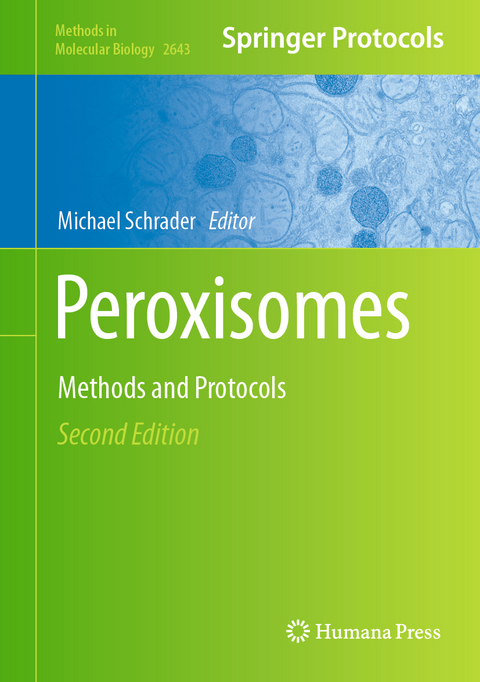
Peroxisomes
Springer-Verlag New York Inc.
978-1-0716-3047-1 (ISBN)
Authoritative and up-to-date, Peroxisomes: Methods and Protocols, Second Edition serves as an ideal guide for researchers working on peroxisome- and organelle-based research questions.
Isolation of Mammalian Peroxisomes by Density Gradient Centrifugation.- Analysis of Yeast Peroxisomes via Spatial Proteomics.- Isolation of Glycosomes from Trypanosoma brucei.- Immunolabeling for Detection of Endogenous and Overexpressed Peroxisomal Proteins in Mammalian Cells.- Super-Resolution Imaging of Peroxisomal Proteins Using STED Nanoscopy.- Direct Stochastic Optical Reconstruction Microscopy (dSTORM) of Peroxisomes.- Correlative Light- and Electron Microscopy in Peroxisome Research.- Ultrastructural Analysis and Quantification of Peroxisome-Organelle Contacts.- Detection of Peroxisomal Proteins during Mycobacterial Infection.- Proximity-Ligation Assay to Detect Peroxisome-Organelle Interaction.- Assay of Reactive Oxygen/Nitrogen Species (ROS/RNS) in Arabidopsis Peroxisomes through Fluorescent Protein Containing a Type 1-Peroxisomal Targeting Signal (PTS1).- Identification of Peroxisome-Derived Hydrogen Peroxide-Sensitive Target Proteins Using a YAP1C-Based GeneticProbe.- Assessment of the Peroxisomal Redox State in Living Cells Using NADPH- and NAD+/NADH-Specific Fluorescent Protein Sensors.- Live-Cell Imaging of Peroxisomal Calcium Levels and Dynamics.- Analysis of Peroxisome Biogenesis by Phos-Tag SDS-PAGE.- Targeted Modifications of the Yeast Genome to Study Peroxisomes.- Applying CRISPR-Cas9 Genome Editing to Study Genes Involved in Peroxisome Biogenesis or Peroxisomal Functions.- Generation of Reporter Cell Lines for Endogenous Expression Analysis of Peroxisomal Proteins.- Peroxisomes and Viruses: Overview on Current Knowledge and Experimental Approaches.- Tools to Investigate the Peroxisome-Dependent Antiviral Response.- Determining the Importance of Peroxisomal Proteins for Viral Infections in Cultured Mammalian Cells.- Characterization of Yeast Peroxisomes: Enrichment of Peroxisomal Fractions and Analysis of b-Oxidation Activity.- A Cell-Free In Vitro Import System for Peroxisomal Proteins Containing a Type 2 Targeting Signal (PTS2).- Assessing Peroxisomal Protein Interaction by Immunoprecipitation.- Purification of a Recombinant Human PEX1/PEX6 AAA+ ATPase Complex from HEK293TT Cells.- Affinity Purification of Soluble and Membrane-Bound Protein Complexes by a FlpIn Strategy.- Utilization of Nonstop mRNA to Assess Ribosome-Associated Nascent Polypeptide Chains in Early Topogenesis of Peroxisomal Proteins.- Computational Evaluation of Peroxisomal Targeting Signals in Metazoa.- Computational Approaches for Peroxisomal Protein Localization.- Estimating the Interaction Strength between PTS1-Peptides and Their Receptor PEX5 in Living Cells Using Flow-Cytometer-Based FRET (flowFRET) Measurements.- Using the Super Folder GFP (sfGFP) System to Study Plant Peroxisomal Protein Import.- Biochemical Fractionation of Trypanosomes for the Analysis of Glycosomal Protein Import Defects.- Manipulation and Visualization of Peroxisomes in Drosophila.- Mouse Models to Study Peroxisomal Functions and Disorders: Overview,Caveats, and Recommendations.
| Erscheinungsdatum | 28.03.2023 |
|---|---|
| Reihe/Serie | Methods in Molecular Biology ; 2643 |
| Zusatzinfo | 66 Illustrations, color; 22 Illustrations, black and white; XVII, 507 p. 88 illus., 66 illus. in color. |
| Verlagsort | New York, NY |
| Sprache | englisch |
| Maße | 178 x 254 mm |
| Themenwelt | Naturwissenschaften ► Biologie ► Mikrobiologie / Immunologie |
| Naturwissenschaften ► Biologie ► Zellbiologie | |
| ISBN-10 | 1-0716-3047-4 / 1071630474 |
| ISBN-13 | 978-1-0716-3047-1 / 9781071630471 |
| Zustand | Neuware |
| Haben Sie eine Frage zum Produkt? |
aus dem Bereich


